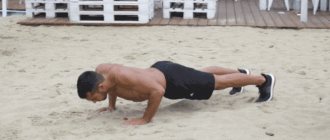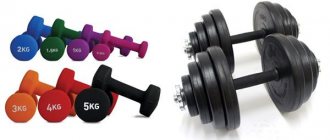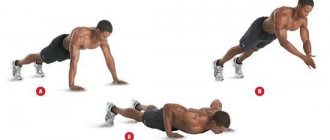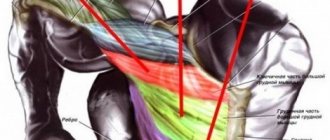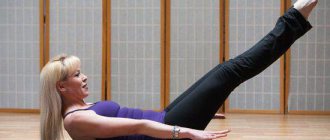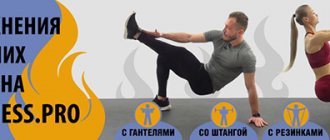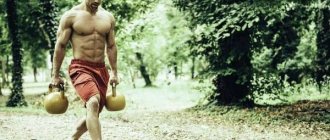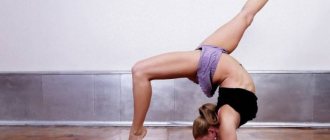Benefits of the crossover pullover exercise
Often, most lovers of strength training neglect the classic pullover due to the complexity of the technique and its specifics, because the effectiveness of the exercise lies in the maximum stretching of the pectoral muscles and triceps. A standing pullover, on the contrary, does not stretch the pectoral muscles and triceps, as when placing a dumbbell behind the head; the technique is clearer and more accessible due to the anatomy of the exercise, or rather, the option is simpler for most trainees.
In addition, a pullover in a crossover is safer and less traumatic. If the free weight of the dumbbell cannot be held and the muscles are severely stretched, then in the version with the upper block, when muscle “failure” occurs, the athlete only needs to return the plates to their place by lifting the arms higher than the top point of the amplitude. In this case, there is no way to drop the weight on yourself or stretch the ligaments, unless, of course, you make a jerk, which is extremely prohibited with any weight.
Crossover trainer: design and training features
Almost every gym has a universal block-type device called a crossover. Its classic design consists of two power blocks connected by a frame. There are other modifications of the simulator:
- single-sided block rack;
- corner crossover;
- triple design;
- double block or block frame.
All crossovers are equipped with upper and lower traction blocks, the height of which is adjustable depending on the height of the athlete and the goals of the activity.
Advantages of working in a block simulator
Crossover training is characterized by great variability: here you can influence the target muscles in a variety of ways from different angles.
Working with free weights has many benefits, but it tends to lose some of the load as you return the weight to the starting position with each repetition. This does not happen in a crossover: due to the specifics of the cable-pulley system, muscle fibers actively work regardless of the phase of the exercise.
Exercise technique: straight-arm pull-down exercise
This option is made with a straight handle. If this grip causes pain, you can change to a curved handle that provides a neutral grip. Let's consider the option of performing it in a crossover, but the exercise can also be performed in a vertical block for the back muscles.
- Place your hands on the handles, shoulder-width apart, with an overhand grip, and place your feet hip-width apart.
- Move back a little from the block, tensioning the cable. Your arms should be straight throughout the entire approach. At the beginning of the movement, the hands should be at shoulder level or slightly above, but do not raise them too high, as you need to maintain constant tension in the back, and not switch to the chest and arms.
- The back should remain vertical, with the exception of the lower back, which should be slightly arched, pushing the pelvis back, but the thoracic region should remain flat. This position ensures constant tension in the latissimus dorsi muscles. It is a mistake to lean forward too much , since the emphasis from the back will shift to the pectoral muscles and triceps. The more vertical the position, the more the lats are loaded.
- The knees should be slightly bent, this will allow you to maintain the arch in the lower back without difficulty and concentrate the load on the back muscles.
- Inhale, and as you exhale, lower the handle with your straight arms down, touching your hips. Additionally, do not bend over, round your chest, or rock. Do not bend your elbows so as not to engage the shoulder muscles. The chest should be open and stretch upward.
- As you inhale, smoothly return your arms up to shoulder or chin level, but not higher.
There are some physiological features that require a slight change in technique.
- For example, tall people should step back more or perform the exercise from their knees.
- Also, the position of the back can be determined by the response of the muscles, for example, an athlete in a vertical position does not feel the work of the back muscles and pulls the block more with his hands, but in a slight tilt he begins to feel the work of the back muscles more strongly.
- The same applies to the choice of handles - it is important to monitor your own feelings, because everyone’s body structure is different.
Common mistakes when doing the exercise
The exercise cannot be classified as technically very difficult, but there are, of course, a number of mistakes that beginners often make.
- You need to keep your back straight. Do not try to bring your arms together at all costs, while rounding your spine.
- Do not press your hands to your body.
- Do not bend your arms, especially if there is a 90-degree angle at your elbow.
- Do not throw your arms after mixing so that they spread under the weight of the weight. The movement must be controlled.
- If the movements are not synchronous, then there is a lagging side. Lighten the weight to maintain your technique. Try mixing with each hand in turn.
- Another mistake can be called improper muscle control during the exercise, but this is not entirely a technical mistake, rather a matter of experience. There is no need to quit the exercise if you feel like you are pulling with your arms or shoulders. Reduce the weight, perhaps it’s just difficult for you to perform the exercise with just your pectoral muscles. Repeat it constantly until you understand the principle.
If you still experience difficulties, then it makes sense to try an alternative - the butterfly simulator. The mixing occurs at a slightly different angle, but the principle is the same. The advantage is that the trajectory is set, and you will always perform the exercise accurately. But this also has a disadvantage, since you will not be able to emphasize the load on the upper or lower chest.
Features of performing a pullover with a rope
The rope is a soft handle with tips that protect the hands from slipping. The instability of the rope, unlike metal handles, adds inconvenience, in the good sense of the word. Thus, the instability of the handle allows you to better work all the muscles on each side. If, when working with a straight handle, the stronger side can compensate for the lack of strength of the other, then this will not happen with ropes, and each working muscle, each of its bundles will be worked out to the maximum.
Recommendations for performing pullovers in the simulator
The standing pullover is an isolating exercise, since only one joint is involved - the shoulder. Accordingly, the exercise should be performed after basic and most complex exercises on the target muscles. For example, a back workout should start with pull-ups, then include basic free weight exercises, block exercises like overhead or waist rows, and only then single-joint isolation exercises like standing pullovers. From complex to simple.
You should not select a large working weight for the exercise. It is impossible to perform this exercise correctly and concentratedly with a large weight. It will also be too much for the accessory muscles. Therefore, large weights are for the base, for isolating ones - moderate weight for 12-15 repetitions of 3-4 sets.
Execution Sequence
» Using the force of inertia and swing. You need to perform the exercise smoothly, without jerking or swaying.
» Do not round your back and shoulders when pulling a pullover at the crossover block. Remember, the back loves an arched lower back and vertical
“The body should not walk from side to side or back and forth. Keep yourself still and fixed at all times.
Number of approaches and repetitions
» For men: 15 - 20 repetitions 4 sets. » For women: 15 - 20 repetitions 4 sets.
How can you replace a pullover standing next to a block?
The exercise, one-arm dumbbell row in an inclined position, will be similar in load.
Crossover exercise - working out the pectoral muscles
People have different attitudes towards the crossover exercise (bringing hands together on blocks).
As a rule, it is included in most bodybuilding programs. But there are a lot of guys who don't even touch it. Most likely you have met such people. They believe that in order to pump up your chest you need to focus on incline and horizontal barbell bench presses and various variations with dumbbells, and nothing else. And in a sense they are right. Basic compound exercises produce the greatest muscle gains.
However, bringing your arms together on blocks (crossover) is one of the most effective exercises on the machine for the development and detailed study of the “drawing” of the pectoral (pectoral) muscles.
What muscles are involved?
The obvious answer is breastfeeding. To be more precise - the upper chest. Some experts argue that the pectoral muscle is one single muscle mass and is not divided into upper, middle or lower parts. But numerous studies have shown that different exercises have different effects on some of its parts. For example, an incline bench press stimulates the upper chest more than a flat bench press. And the head-down press mainly works the lower chest. Therefore, of course, there is still a difference between the exercises. Let's return now to the crossover.
It works the upper chest to a much greater extent than the lower chest. However, there are ways to modify the execution technique in order to pump up the bottom. For example, when pulling the handle below the waist, the lower chest is activated. However, this exercise is not used in this way. Reverse push-ups and head-down incline presses are best for this. The main conclusion is simple - although the crossover (bringing the arms together in a block) can load the entire chest, it is still especially effective and advisable to use it for the upper chest.
The advantage of crossovers
Performing exercises in a block simulator has its own specifics. As for such an exercise as a crossover, its main advantages are as follows:
- The pectoral muscles are under load all the time. The resistance of the blocks does not allow them to relax even for a second. While when performing chest exercises with dumbbells or a barbell, the effort is more of an impulse nature.
- By varying the position of the body and the direction of the information, you can work different areas of the pectoral muscles. So, for example, if we do a crossover from top to bottom, the lower chest is working. If, on the contrary, we pull up the handles of the lower blocks, the emphasis is on the top of the chest. By doing the crossover directly in front of us, we are working on the center.
- The crossover technique involves stretching the target muscles at the top. This allows you to increase the range of motion and force the muscle to contract as much as possible.
- Because this exercise doesn't use heavy weights, it's much safer for your shoulder joints than, say, a bench press.
Execution technique
It is performed on a block simulator: two vertical racks that are connected at the top by a frame. Adjustable weights moving on cables are placed on the racks. Handles are attached to the other ends of the cables, which the athletes pull on.
Stand between the posts with one foot slightly in front (staggered position).
Grasp the handles of the blocks. Elbows slightly bent, palms facing each other.
Bring your hands together until they touch, and it is advisable to cross your wrists slightly.
Concentrate on tightening your chest rather than focusing on your arm muscles.
Perform smoothly, without swaying; movements should occur only in the shoulder joint. Do not try to facilitate movement due to inertia.
Don't start with a jerk at the start - this reduces efficiency. And also do not throw the weight in the negative part of the amplitude.
Typically, the most common mistake that most guys and girls make is placing their elbows at the same level as their shoulders, and sometimes even raising them higher than their shoulders. This is exactly the same mistake that many people make when doing dumbbell flyes or butterfly curls.
This position of the elbows not only reduces the load on the chest, but also rotates the shoulders into a very undesirable position.
Shoulders are one of the most easily injured body parts in strength sports. And the high position of the elbows is very dangerous. The same applies to the standing overhead bench press.
For proper technique, three things need to be monitored:
Elbows below shoulders
. Slight tilt of the torso forward. As a result, you achieve two things: greater involvement of the pectoral muscles, and it also helps keep the elbows below shoulder level. From a pecs perspective, the principle is the same as reverse push-ups. Leaning forward recruits more muscle fibers from the pectoralis muscle.
Full extension of arms to the sides
. In this case, the muscle lengthens - a process that is the opposite of the contraction of muscle fibers, when we pull the blocks forward and down and feel tension in the chest. It is because of this tension that many consider this phase of the movement to be more important. However, research shows that the arms-out phase of the exercise is just as (if not more) important for muscle growth. Therefore, it is important to feel the full extension and even tension of the pectoral muscles when the elbows go completely behind the back (the elbows are always below shoulder level). The stretching phase is key in gaining muscle mass.
Blocks overhead.
Usually no one discusses this. The vast majority of block exercise machines have the ability to adjust the position of the block. Either way, try to make sure the blocks are above your shoulders (preferably above your head).
Then, when the upper half of the body tilts, the pectoral muscle is pulled forward and down.
Try to cross your arms
. Crossover, translated from English, means “crossing.” This name is not accidental. You need to actually cross your arms until your wrists cross. This is one of the few chest exercises that allows you to do this, while working a large number of muscle fibers deeper.
You need to perform a crossover at the end of a chest workout - 3 sets of 10-15 repetitions.
Ten best exercises on blocks
They represent a selection of the most effective exercises, which, for one reason or another, disclosed in the presented description of each, should be included in the main training program for increasing muscle mass.
No. 1 Pulley block to the belt from a sitting position
It is a multi-joint exercise that is aimed at training the back using several muscle groups, allowing you to use fairly heavy weights. It, unlike a single-joint one, stimulates the production of much more testosterone and growth hormone in the body of athletes. This has a positive effect on muscle growth. You can work with both the lower and upper grip, as well as with a narrow and wide grip.
It is best to perform this exercise at the end of a workout to develop your back muscles. First you need to work with heavy weights, performing deadlifts, bent-over rows with a barbell, supplementing, if possible, with T-bar rows. Expanding the range of motion is achieved by performing the exercise with one hand.
No. 2 Pulldown of the lower block to the chin
Aimed at working out the shoulder girdle. It is one of the best ways to engage and train the middle fascicle of the deltoid muscle group. Gives the greatest effect with a wide grip. Maximum isolation is achieved by occupying one of three positions - standing with cables (two), on the floor, sitting. Performing with a bar that has rotating handles allows you to relieve the stress on your wrists.
This exercise is best done before single-joint deltoids and after heavy overhead presses. It is often used as a closing dropset when people want to work out the middle fascicles of the deltoid muscles to the maximum.
No. 3 Thrust of the upper block to the chest
Working with free weights involves moving your arms perpendicular to your body. In this back exercise with a block machine, the amplitude is much greater. In addition, the athlete has the opportunity to experiment with different grips and types of bar, which is also an undeniable advantage.
Many athletes perform this exercise as a warm-up for the shoulder girdle, since it has a high range of motion. And if regular pull-ups make it difficult to increase the load, then doing heavy approaches on blocks is much easier. Pulling blocks to the chest can also be done after free weight exercises that follow the warm-up.
No. 4 Bending arms in a crossover from a standing position
This is perhaps one of the best variations of biceps development in such a simulator as a crossover. Its high efficiency is due to the ability to change the height of both the block itself and the position of your own body. This exercise is an excellent choice for those athletes who have a shoulder injury, as it provides the joint with almost complete freedom of movement.
The exercise is not characterized by a high load; it is great for performing in those moments when there is a need to reduce the intensity. It can also be done using fairly heavy weights. The main thing, when reaching muscle failure, is to be sure that the inertia of movement is not involved.
The latter is due to the fact that due to cheating the execution technique is disrupted. This results in an increased risk of injury. Workouts with sets of six or eight repetitions are recommended to be performed with both arms, either a barbell or an EZ bar.
No. 5 Bringing hands together in crossover
Unlike many other chest exercises, it allows you to easily change the angle of resistance. If it is necessary to work the lower part of the pectoral muscles, the blocks are placed at the top, and if the emphasis is on the upper part, then, on the contrary, the blocks are placed at the bottom. Similarly, a change in the point of bringing the hands together is required.
It is made the penultimate or final one in training. When two isolation chest exercises are performed at once during a class, the muscles should be worked from different angles. Otherwise, the loads will be unidirectional, which is not effective.
It is a work on the deltas, which involves swinging to the sides and raising the arms in an inclined position. Recommended for inclusion in training, since block exercise machines were designed specifically for single-joint exercises.
The triset allows you to develop literally every fascicle of the delta, holding the handle and not releasing it. You can spread your arms while standing or bending over, raise them in front of you or swing them to the sides.
This triset usually completes the workout. In what part of the lesson to do this exercise is not of paramount importance. The main thing is to make sure that the work on each beam is the same and not different.
No. 7 Crossover crunches
It differs from similar exercises performed with your own weight in the ability to conduct training with an unlimited number of repetitions, the number of which depends on the goal set for the athlete, as well as the adjustment of maximum loads. Crunches can be performed either on the knees, when the emphasis is on the upper abdominals, or while standing, if it is necessary to work the oblique muscles.
The crossover exercise is done either first or second in training to work the abdominal muscles. Taking a light weight and thereby increasing the number of repetitions, you can do crunches closer to the end of the session.
Comparison with other exercises
As discussed earlier, the crossover is one of the best exercises for the chest if done correctly. How effective is it compared to other exercises? To begin with, it is mainly intended for the upper chest. In this sense it works great.
According to electromyography (EMG) conducted by Bret Contreras, the greatest activation of the fibers of the upper pectoral muscle is achieved during the incline bench press. And the largest average activation is when performing a crossover. Simply put, as a result of a large amplitude of movement, the greatest average activation of muscle fibers occurs - the upper pectoral muscles are held in tension longer than in any other exercise. In this sense, it is superior to the incline press, which most people consider the best exercise. This study also included:
- bench press
- Lying arm raises with dumbbells
Another study from the University of Wisconsin compared nine of the most popular chest exercises. Here's what they came up with: the bench press, butterfly, and crossover are the three clear winners in terms of muscle activation. It is important to add that this means the entire pectoral muscle: upper, middle and lower parts.
The places were distributed as follows:
The bench press is the winner and was awarded 100%.
Butterfly trainer - 98% muscle activation.
Crossover - 93% muscle activation. It is important to note that this was a crossover with a slight forward lean to the body.
Crossover exercises for the upper body.
In our previous article, we already told you about some exercises on a multifunctional crossover trainer. Today we will take a closer look at exercises that allow you to harmoniously develop your upper body. Thanks to the use of this block simulator, you can effectively work out the arm muscles: biceps, triceps, deltoids, brachialis and other muscles, pectoral muscles, back muscles and abs.
Almost all of the exercises listed below are isolating, which means they are designed to deeply work a specific muscle group. Exercises on the upper blocks will help create a beautiful muscle relief. Most often, the crossover is used by athletes who are on a “drying” period, during which the maximum sharpening of the relief occurs. The cable-block system of the simulator allows you to keep your muscles in good shape throughout the entire exercise.
Shoulder and arm workout.
The lat pulldown is a classic exercise for working the triceps. Using a soft rope handle allows you to achieve maximum amplitude and work the deep layers of muscles.
Stand facing the machine and lean your body forward slightly, standing on “soft knees.” To improve resistance, one leg can be placed forward. Maintaining a natural arch in your lower back, straighten your chest and, while inhaling, lower the handle of the exercise machine down towards the front of your thigh. Elbows should be pressed to the body and remain static. Having reached the bottom point of the movement, hold for 1-2 counts. As you inhale, smoothly return the handle to its original position. The exercise is performed 10-15 times for 3-5 approaches.
Without changing the cable handle, perform another exercise using the upper block of the crossover - row to the chin. In this case, the posterior bundle of deltoid muscles is loaded, which is extremely difficult to work out with basic exercises.
You need to stand at a distance of 1.5 meters from the crossover, holding the rope handle in your hands. Inhaling, pull the handle of the exercise machine towards your chin. During the movement, your elbows should be higher than your forearms. At the end point of the movement, hold the position of the body, maintaining tension with the rear delts. The body is positioned level. As you inhale, take your starting position. For 1 approach, 10-12 repetitions are performed. A total of 2-3 sets of deadlifts are done.
Using a steel crossover handle, you can work your back muscles, for example, by performing lat pulldowns with straight arms. The pullover will help you get a V-shaped back by working your latissimus dorsi muscles. The grip of the handle should be wide. Take 1 or 2 steps back while facing the crossover. The stand is carried out on slightly bent knees. It is necessary to tilt the body forward slightly - about 30 degrees. Using straight arms, pull the handle toward your body. Stopping at your hips, hold the handle for 1-2 seconds. Focus on the peak muscle contraction. The return of the handle occurs while inhaling at a slow pace. To eliminate shoulder work, do not raise your arms too high. The exercise is performed in 3 sets of 15-20 repetitions.
To work the anterior head of the delta and trapezius muscles, you can perform arm raises while sitting on a bench. This exercise uses a lower crossover block as well as an incline bench.
Set the incline of the bench to 45-60 degrees. Sitting on a bench, pull the handle diagonally towards you with straight arms, so that at the highest point your arms are above your head. Hold the position of the body with the rope taut for 1-2 counts. Repeat 10-15 times. The diagonal movement will help maximize the load on the muscles and stimulate the growth of the anterior shoulder muscles.
If your goal is a beautiful lateral head of the deltoid muscle, then perform abduction of one arm to the side while lying or sitting on an inclined bench. The tilt angle should be approximately 35-45 degrees. For traction, attach a D-handle to the crossover. Take a lateral position on an incline bench and perform a one-arm bar row up. Make sure that the deltoid muscle contracts as much as possible. At the top point, freeze for 1-2 seconds and slowly return your hand to its original position. An unusual angle of inclination will help to engage those muscles that usually do not work when performing basic exercises.
When performing pulling exercises, you can use several handles at once. For example, in the exercise of raising arms to the sides from a sitting position. Thanks to this exercise, the rhomboid muscles, the posterior head of the deltoid muscle, and the middle part of the trapezius muscle are well worked out. Place a bench in the middle of the double crossover. The torso should be 30 centimeters from the blocks. Grabbing the handles, pull them to the sides until the shoulder blades on your back come together. For more intensity, try to move your elbows back and down. When you feel that your shoulder blades are connected, hold the position of your body for 1-2 counts.
Using two handles at once will also help pump the clavicular muscle of the pectoralis muscle. Change the angle of the bench to about 70 degrees, placing it in the center of the distance between the two crossovers. Grab the handles so that your shoulders are at a 70-degree angle to your torso. Lie with your back on a bench and bring your arms in front of you so that they intersect near your nose. At the top point, hold for 1-2 seconds. Then, slowly return to the starting position. This exercise, a hybrid of the crossover row and the butterfly exercise, will help pump up the upper chest.
If your goal is biceps, an exercise on the upper crossover block will help you strengthen it. In addition to the biceps, the brachialis is worked on, which visually affects the size of the biceps itself. For this exercise you will need a short and straight handle. Sit comfortably on a sports bench, fixing your legs behind the bolsters. Grab the handle with a wide grip. Lean back slightly as you lower the barbell down behind your head. At the lowest point, the biceps should be bent as much as possible. Due to the flexion of the arm, the biceps is not so much involved in the process of flexing the forearm, giving this function to the brachialis.
Triceps can also be worked on an incline bench at an angle of 45 degrees, which must be installed at a distance of 60-90 centimeters from the crossover. Sit on it so that your head faces the block. Lean your back on the bench and pull the handle towards you. In this case, your elbows should be slightly apart. At the maximum point, when the handle is approximately at the level of your eyes, pause a little and smoothly return your hands to the starting position.
Exercises at home without special equipment
A set of training exercises can be performed without the use of sports equipment. It is enough to do daily push-ups. Only exercises aimed at developing muscle mass differ from classical physical education classes.
- Stand with your back to the wall, bend over. With your hands shoulder-width apart, rest your hands on the floor.
- Raise both legs one at a time, using the wall as a fulcrum.
- Maintaining an upside-down position, begin push-ups on your hands.
The exercise is very difficult for beginners, and at first it is better to have someone nearby for backup. With persistence over several weeks, you can independently achieve effective results by applying your own weight to the shoulder muscles.
Having mastered push-ups against a wall, move on to the exercise without support, and then try walking on your hands, which will give your body definition
Just keep in mind that this exercise has contraindications. It affects brain activity and increases blood pressure
The second exercise, which does not require additional equipment, is performed in a lying position. Lean on your toes connected together and your elbows, which should be pulled back, clasp your hands close to your chest. In this position, lift your body as high as possible and return to the starting position, holding at the highest point for 5-10 seconds. Do 15-20 of these movements in three sets.
From a standing position, lean forward at a right angle, resting your hands on the floor. Pull yourself up on your toes, lower your head until it touches the floor. The arms should bend at the elbow joints. Returning to the starting position, repeat the exercise as much as possible.
Exercises with dumbbells The most common and easiest way to pump up your shoulder muscles at home is to use dumbbells.
- In a standing position, place your feet shoulder-width apart. At the same time, spread both arms with the apparatus to the sides, try to keep them parallel to the floor. Adjust the number of lifts yourself, gradually increasing (they should be performed easily and naturally).
- Perform the movements similar to the previous exercise, only raising your arms with dumbbells not to the side, but forward. The inner side of the palms should be turned upward.
- Bend your knees slightly, pelvis slightly forward. Lower your arms with dumbbells along your body, begin to lift them to chest level, bending at the elbows.
- Sit on the floor, leaning your body back slightly, bend your knees. Raise your hands with the apparatus above your head, then spread them to the sides.
- Lie on your side. Hold the dumbbell in one hand, slightly bent at the elbow, and begin lifting and lowering in cyclic movements.
Such exercises will help pump up your biceps, forearm, and deltoid muscles. The effectiveness of the final result increases as the weight of the projectile increases.
Once you have mastered dumbbells, decide what your ultimate goal is. To build muscle, you need to increase the weight every 10-15 repetitions. If you want to strengthen the shoulder girdle and give it definition, select a projectile so that you can reach 25 repetitions. If you don’t like too bulky forms, choose individual exercises and light weights of equipment, and do the workout itself at a slow pace.
Exercises on the horizontal bar and with a barbell You can pump up your muscles at home by performing a complex on the horizontal bar. First, learn how to do pull-ups correctly. The basic rule is to grasp the crossbar in such a way that the thumb does not touch the palm. Perform the exercise slowly 10 times, making 4 sets.
Next, perform a narrow grip - this is when the distance between the hands does not exceed 15 cm. And again, 4 approaches, but this time 12 pull-ups each.
One of the main techniques for building muscle mass is barbell training. Standing position, feet shoulder-width apart. Raise the barbell sharply, placing it on your upper chest area. Inhale and lift it above your head. Lower slowly as you exhale to increase the load on the deltoid muscles. Repeat 10-12 times.
Transition device
A crossover (from the English crossover, transitional or boundary device) is a multifunctional simulator with cargo blocks.
It is designed for different muscle groups. Crossovers come in different types: power, corner, for professionals, for amateurs, with an adjustable horizontal bar, etc.
The simulator has cargo traction blocks - upper and lower, their height is adjustable. Trainers believe that a crossover is a good strength training device that can replace simpler sports equipment.
Using a crossover, you can work the muscles of the back, shoulder girdle, arms, legs, chest and buttocks.
What is it needed for
It is appropriate to purchase a crossover only for gyms. It is unlikely to be suitable for home (it is quite bulky).
Of course, if your living space allows it, then you can buy this exercise machine. In any case, it is a useful unit for muscles.
Men like to use the crossover to give their muscles a clear definition. It is also held in high esteem by women: the lower block of the simulator works the muscles of the legs and buttocks.
How to use
Next we will talk about the basic and most popular exercises on this simulator.
Exercises for the shoulder girdle
Do you agree that the importance of the shoulder girdle is quite difficult to overestimate? For the stronger half of humanity, pumped shoulders are needed to give a silhouette to the upper body.
For women, shoulders emphasize the femininity of the figure, helping to create the illusion of a thin waist.
It is necessary to take the handles of the simulator in both hands and move away a short distance (where the crossover resistance begins). We raise our hands in front of us.
We hold them straight, parallel to the floor and perpendicular to the body. Feet should be placed shoulder-width apart and pressed firmly to the floor.
We take a breath, begin to spread our arms to the sides and back. While moving, keep your arms extended and parallel to the floor.
Then we continue moving in the opposite direction. Our hands do not touch each other at the end.
We take the handle of the simulator in one hand and move away a short distance. The arm is slightly bent at the elbow joint. We press our feet tightly to the floor, placing them shoulder-width apart.
We take a breath and stretch our hand to the side. The elbow is directed slightly back and up. We try to keep our shoulder straight, and don’t move it or raise it anywhere.
This video shows how to do the exercise correctly.
- Swing your arms backwards while bending over
We stand in the middle of the simulator. We take the crossover handles in both hands. We place our feet shoulder-width apart. We bend the lower back - bend forward. We bend our elbows slightly.
Let's start working with our hands. We try not to jerk our shoulder blades. Keep your back in place. Elbows at the top should point to the ceiling.
You can view this exercise here:
Exercises for the pectoral muscles
- Crossover (or crossover)
This is the most popular exercise. It is named after the simulator. There are many options for performing exercises.
Can be done with both large and small weights; both with two hands and alternately; both standing and lying down.
We take the handles of the simulator in our hands. Feet - shoulder width apart.
We begin to bring our arms down and then raise them up, while spreading them at shoulder level. Below we linger for a few seconds. Then we slowly rise up.
It is important to monitor your body position. The body should be straight, the elbows should not bend at right angles.
The technique and all the nuances can be seen in this video:
It is necessary to move the bench with an adjustable tilt angle of 30-35 degrees. This will work the middle of the pectoral muscles. This exercise is similar to lying down with dumbbells.
More details here:
What muscle groups need to be trained to build a massive back?
The latissimus muscles are located in the central part of the back. They are responsible for the formation of such an aesthetically attractive and desired V-shape by all athletes.
The trapezius muscles, often referred to simply as the trapezius, are located in the upper back.
- Posterior deltoid muscle
The posterior bundle of deltoid muscles is located behind the shoulders. Typically, these muscles are worked during shoulder workouts, but they can also be worked during back workouts.
Leg exercises
- Leg abduction in crossover
You need to go to the lower block of the simulator and set the required weight. We stand sideways to the simulator. We put the cuff on the ankle.
We put our feet together. Transfer your body weight to your free leg. We tear the other leg off the floor.
Let's take a deep breath. We move the leg with the cuff to the side. Slowly return the leg to the machine, slightly crossing it with the other leg. We do the same with the other leg.
This is a classic exercise. In fact, there are many variations of this exercise. It can be performed lying on a bench, on all fours, facing and back to the crossover, etc.
I suggest you familiarize yourself with various exercises in this video:
Working muscles
The target muscles for this exercise are the pectorals. Depending on the variation of the exercise, it is possible to emphasize the load on their lower, upper or inner parts.
The pectoral muscles are targeted when performing the exercise.
The muscles of the shoulders, arms and back are used as additional muscles. A number of muscles in the body perform a stabilizing function. In particular, these are the muscles of the abs, legs and buttocks.
